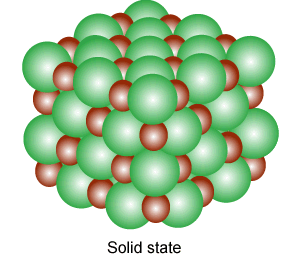What type of bonds are present in molecular crystals?
What type of bonds are present in molecular crystals?
Solution and Explanation
Molecular Crystals:
Molecular crystals are made up of individual molecules that are held together by intermolecular forces. These crystals have a unique structure, and the bonding between the atoms within each molecule is typically covalent in nature. This means that electrons are shared between adjacent atoms within the molecule to form molecular bonds, creating a stable structure within the individual molecules.
Types of Bonding:
- The bonding within the molecules is covalent, meaning that atoms within a molecule share electrons to achieve a stable electron configuration, typically resulting in strong and directional bonds.
- However, the forces that hold the individual molecules together in the crystal lattice are weaker than the covalent bonds and are known as intermolecular forces. These forces arise from interactions between partially charged atoms or molecules within the crystal lattice.
Intermolecular Forces:
The key types of intermolecular forces that play a role in the formation of molecular crystals are:
- London Dispersion Forces: These are temporary attractive forces that arise from the movement of electrons, creating temporary dipoles in molecules. They are present in all molecular crystals, even in nonpolar molecules, and are generally weak.
- Dipole-Dipole Forces: These occur between molecules that have permanent dipoles. In polar molecules, the positive end of one molecule is attracted to the negative end of another molecule, which can contribute to the stability of the crystal structure.
- Hydrogen Bonding: This is a special type of dipole-dipole interaction, which occurs when a hydrogen atom covalently bonded to a highly electronegative atom (such as oxygen, nitrogen, or fluorine) is attracted to another electronegative atom. Hydrogen bonding is stronger than other intermolecular forces and plays a crucial role in the formation of molecular crystals, especially in compounds like water and ammonia.
Conclusion:
In a molecular crystal, covalent bonds are responsible for holding the atoms together within each individual molecule, while the intermolecular forces, including London dispersion forces, dipole-dipole forces, and hydrogen bonding, are responsible for holding the molecules together in the crystal lattice. The presence of these weaker forces between molecules results in a more flexible and lower-melting structure compared to ionic or metallic crystals.
Top Questions on The solid state
- A metal crystallizes in simple cubic lattice. The volume of one unit cell is \( 6.4 \times 10^{-7} \, \text{pm}^3 \). What is the radius of the metal atom in pm?
- AP EAPCET - 2025
- Chemistry
- The solid state
- A metal crystallises in two cubic phases, fcc and bcc with edge lengths 3.5 Å and 3 Å respectively. The ratio of densities of fcc and bcc is approximately
- TS EAMCET - 2025
- Chemistry
- The solid state
- How many kinds of Bravais lattice are possible in a crystal?
- Bihar Board XII - 2025
- Chemistry
- The solid state
- The percentage of free space in a body-centred cubic unit cell is
- Bihar Board XII - 2025
- Chemistry
- The solid state
- The number of atoms present in body-centred cubic unit cell is
- Bihar Board XII - 2025
- Chemistry
- The solid state
Questions Asked in MHT CET exam
- Evaluate the integral: \[ \int \frac{\sqrt{\tan x}}{\sin x \cos x} \, dx \]
- MHT CET - 2025
- Integration
- A 5-ohm resistor is connected to a 10 V battery. Calculate the current flowing through the resistor.
- MHT CET - 2025
- electrostatic potential and capacitance
- The electric field at a point in space is \( 2 \times 10^3 \, \text{N/C} \) and the potential at the same point is \( 100 \, \text{V} \). What is the potential energy of a charge of \( 5 \, \mu\text{C} \) placed at that point?
- MHT CET - 2025
- electrostatic potential and capacitance
- Two point charges \( +4 \, \mu\text{C} \) and \( -2 \, \mu\text{C} \) are separated by a distance of 0.3 m in air. What is the magnitude of the electrostatic force between them?
- MHT CET - 2025
- electrostatic potential and capacitance
- A current of 2 A flows through a conductor with a resistance of 5 \(\Omega\). Calculate the potential difference across the conductor.
- MHT CET - 2025
- Resistance
Concepts Used:
Solid State
Solids are substances that are featured by a definite shape, volume, and high density. In the solid-state, the composed particles are arranged in several manners. Solid-state, in simple terms, means "no moving parts." Thus solid-state electronic devices are the ones inclusive of solid components that don’t change their position. Solid is a state of matter where the composed particles are arranged close to each other. The composed particles can be either atoms, molecules, or ions.

Types of Solids:
Based on the nature of the order that is present in the arrangement of their constituent particles solids can be divided into two types;
- Amorphous solids behave the same as super cool liquids due to the arrangement of constituent particles in short-range order. They are isotropic and have a broad melting point (range is about greater than 5°C).
- Crystalline solids have a fixed shape and the constituent particles are arranged in a long-range order.